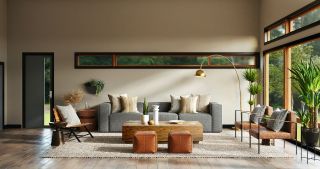Environment
The Neuro-Architecture Triad: A Cheat Code for Designers
Here's how to incorporate subjective experience into building design.
Posted January 24, 2024 Reviewed by Davia Sills
Key points
- Ideally, architects would inform their practice by taking into account human needs, desires, and preferences.
- How to do so, given the many sensory, emotional, and semantic elements to integrate, is not straightforward.
- Human experience of spaces distills into three psychological responses: coherence, fascination, and homeyness.
- The neuro-architecture triad offers a cheat code for design choices.

Tailors and their craft
Imagine an extraordinary tailor who fashions clothes from scratch. They know their craft, whether working with silk, cotton, or wool. They incorporate biologically inspired fabrics printed from shrimp shells and spider webs. They are socially conscious, caring that workers not be exploited and prioritizing the sustainability that is critical to the health of our planet.
What if the very same talented tailor didn’t care about human psychology and physiology? Could they make a desirable cover for our body?
Buildings as cladding
If we think of clothing as a form of cladding similar to the way that buildings clad most of us 90 percent of the time, then we might ask the same questions of architects and designers that we would of our imaginary tailor. Architects give a lot of thought to formal features of space and the properties of their materials, whether they be wood, brick, or concrete. They might be socially conscious and care about the well-being of their workers and the source and sustainability of their supplies.
But what if they didn’t consider the very humans who inhabit the spaces they build? What do people feel and desire in a space? How might the design of spaces help people flourish? Could architects take the aesthetic needs that we all have seriously?
It is easy to ask architects to inform their design practices with human psychology and neuroscience; it is not so easy to imagine how they might do so. Consider the Aesthetic Triad1, a psychological framework for understanding aesthetic experiences. The triad consists of sensory-motor, emotion-reward, and semantic-meaning systems.
One might consider the sensations of color, light, shape, and pattern and how the environment engages our motor systems (called “affordances” by academics). One might consider feelings such as contentment or wonder or awe or revulsion. One might consider the meaning of the building (home, school, or hospital) and the personal and cultural histories of its inhabitants.
These are a lot of variables that undoubtedly interact. Ask any statistician: Interpreting the effects of interactions that involve many variables is nearly impossible. For example, the same color might be experienced differently with different light, shape, and pattern, let alone in different rooms for different people.
The Neuro-Architecture Triad
I suggest that a level of abstraction might rein in these unwieldy variables and be useful for designers who take the psychology and neuroscience of people seriously. This abstraction centers on people’s psychological responses to the built environment rather than its concrete features. In several publications2,3, my colleagues and I reported that another triad of responses captures human reactions to the built environment. Our brains respond to these psychological dimensions even when we are not consciously aware of our response4. This architectural triad consists of 1) coherence—how organized and legible a space appears, 2) fascination—how complex and informationally rich the experience of the space is, and 3) homeyness—how much the space engenders a sense of belonging and comfort.
My claim is that these dimensions generalize across people and buildings. Their expression and weightings might vary by context. For example, we reported that people on the autism spectrum experience fascination differently than neurotypical people. We suspect that the informational density that is characteristic of fascinating spaces to most people is overwhelming for people on the spectrum5. Similarly, different dimensions might be prioritized differently based on the building’s purpose. We might emphasize fascination for a sports stadium, coherence for a train station, and homeyness for a rehabilitation facility.
Rather than try to take account of individual features, like the interplay of form, color, and pattern across different lights and scales, it is easier to judge a space for its coherence, which likely arises from different combinations of such elements. Similarly, it is easier to judge a space that invites exploration and feels fascinating than to work up to this sensibility by selecting specific details that might contribute. Finally, people will know if a space feels homey to them, rather than check off items like plants, soft textures, and warm light to invite a sense of belonging.
When we hear language, we comprehend words and their meaning and only secondarily can become aware of the sounds (phonemes) that make up the words. When we recognize objects in the world, we recognize the whole thing and only secondarily its elemental features, like color, shape, and texture. Similarly, when we inhabit space, we respond to its coherence, fascination, and homeyness. The architect can decide how to weigh the three broad dimensions and then secondarily make choices about specific features that comprise those dimensions.
References
Chatterjee, A., & Vartanian, O. (2016). Neuroscience of aesthetics. Annals of the New York Academy of Sciences, 1369(1), 172-194. https://doi.org/10.1111/nyas.13035
Weinberger, A. B., Christensen, A. P., Coburn, A., & Chatterjee, A. (2021). Psychological responses to buildings and natural landscapes. Journal of Environmental Psychology, 77, 101676. https://doi.org/10.1016/j.jenvp.2021.101676
Chatterjee, A., Coburn, A., & Weinberger, A. (2021). The neuroaesthetics of architectural spaces. Cognitive Processing, 22(Suppl 1), 115-120. https://doi.org/10.1007/s10339-021-01043-4
Coburn, A., Vartanian, O., Kenett, Y. N., Nadal, M., Hartung, F., Hayn-Leichsenring, G., ... & Chatterjee, A. (2020). Psychological and neural responses to architectural interiors. Cortex, 126, 217-241. https://doi.org/10.1016/j.cortex.2020.01.009
Vartanian, O., Navarrete, G., Palumbo, L., & Chatterjee, A. (2021). Individual differences in preference for architectural interiors. Journal of Environmental Psychology, 77, 101668. https://doi.org/10.1016/j.jenvp.2021.101668


